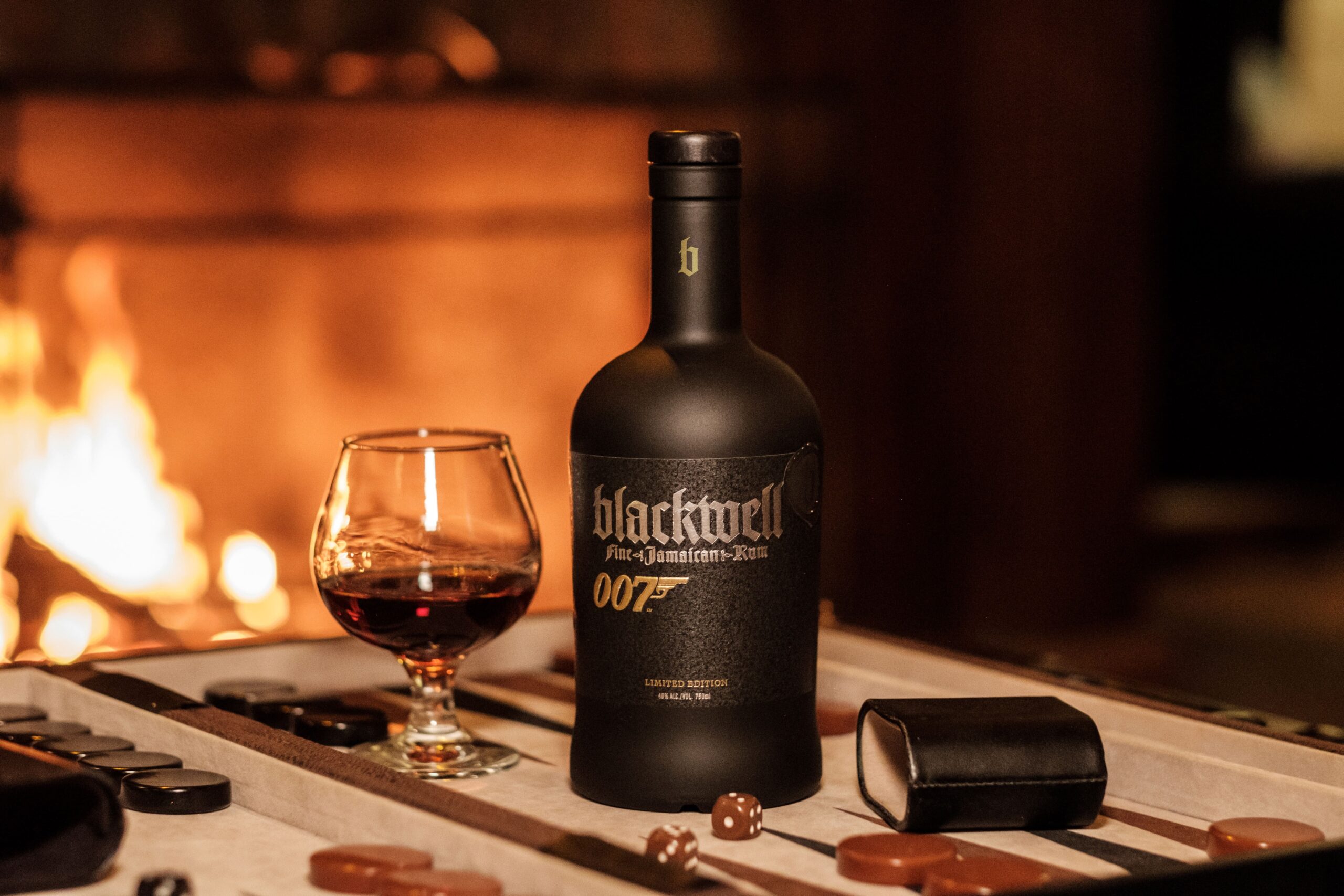James Bond 007 Jamaican Rum by Blackwell Rum. Limited edition release of Blackwell Fine Jamaican Rum, that was launched in partnership with the 007 movie franchise to celebrate Bond’s links to Jamaica, from Ian Fleming to Dr. No (1962) and No Time To Die (2021). Image courtesy Blackwell Rum.
I take a ridiculous pleasure in what I eat and drink.” — Ian Fleming
James Bond was not a man who drank rum often, but he had to admit that the Caribbean Island he was visiting had some of the finest he had ever tasted. He sipped his glass of dark amber liquid, feeling the warmth and spice of it on his tongue, as he watched the sun set over the turquoise sea. He was here on a mission, of course, but he also enjoyed the perks of his job: exotic locations, beautiful women, and a license to kill. He wondered what his next move would be, and who he would have to face in his quest to stop the evil organization from holding the world to ransom. He knew he could handle anything that came his way, as long as he had his trusty Walther PPK.

British author, journalist and Word War II Naval Intelligence officer Ian Fleming, who is best known for creating the fictional spy James Bond, was a fan of rum, especially the Jamaican variety, which he often drank while writing his novels. He once said, “Don’t talk to me about naval rum. Too sweet. The best rum in the world is Jamaican. It has more bouquet, more flavor, more everything.”

Fleming was known to incorporate his personal preferences, into his stories, including his love for rum. Rum was not only a source of pleasure for Fleming, but also a way of connecting with the Caribbean culture that he loved and admired.
Sun, sea and rum.” — Popular Jamaican saying
Chris Blackwell, the founder and owner of Blackwell Rum, a premium Jamaican rum brand, is the owner of GoldenEye, a luxury boutique resort and former Jamaican seaside home of Ian Fleming. Fleming wrote 12 novels and two collections of short stories at GoldenEye. Blackwell, who is also the founder of Island Records and a legendary Rock & Roll Hall of Fame music producer, has a long history of supporting and promoting Jamaican artists, musicians and writers, and his rum and resort are both expressions of his love for the island and its people. Blackwell served as a location scout on the first James Bond film Dr. No (1962), starring Sean Connery. Blackwell Rum was featured in the most recent Bond film, No Time To Die (2021), starring Daniel Craig.

Rum has a rich and complex history that spans centuries and continents. Rum originated in the Caribbean islands in the 17th century, where slaves discovered that they could make alcohol from the byproduct of sugarcane refining. Rum became very popular in the American colonies and later in other parts of the world.
The Naval Tradition
Fleming’s James Bond was Royal Naval Reserve Commander. One of the most notable aspects of rum’s history is its long association with the navy, especially the British Royal Navy. Rum has been an integral part of the Royal Navy’s history and culture for over two centuries. Rum was a common drink among sailors, who often received a daily ration of it as part of their pay. Rum was also used as a currency, a medicine, and a morale booster. Rum was so important to the naval culture that it influenced many traditions,
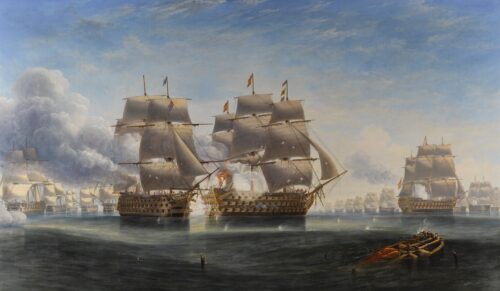
The history of rum in the Royal Navy dates back to the 17th century, when British ships captured Jamaica from the Spanish and gained access to the local sugar cane plantations and distilleries. Rum soon became the preferred drink of the sailors, who received a daily ration of half a pint of spirits, which they could either consume neat or trade for other goods.
In 1740, Admiral Edward Vernon ordered that the rum ration be diluted with water to reduce drunkenness and improve discipline. He was nicknamed “Old Grog” after his grogram cloak, and the watered-down rum became known as “grog”. The rum ration, or “tot”, was measured out by the purser, or “pusser”, and served at midday.
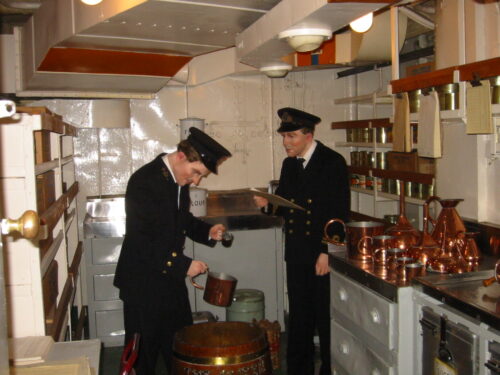
The rum ration was further reduced over time, until it reached one-eighth of an imperial pint (71 ml) of rum at 54.6% ABV, given out at midday. This was known as the “tot”, and it was a cherished ritual for many sailors, who would often trade or save their tots for special occasions. The tot was also used as a reward or a punishment, depending on the captain’s discretion. The rum ration was finally abolished in 1970, after concerns that it was incompatible with modern naval operations and safety standards. The last day of the rum ration, 31 July, was known as Black Tot Day, and it was marked by ceremonies and mourning across the fleet.
The Royal Navy’s rum has left a lasting legacy in the world of spirits, as it inspired brands such as Pusser’s® Rum and Lamb’s® Navy Rum, which claim to follow the original recipe and strength of the navy rum. The navy rum also gave rise to terms such as “proof” and “splice the mainbrace”, which refer to the methods of testing the content of alcohol and an order rewarding the crew the with a drink, typically a tot of rum, respectively.
How Rum Is Made
The making of rum is a complex and fascinating process that involves several steps and ingredients. Rum is a distilled alcoholic beverage made from sugarcane byproducts, such as molasses or juice, or directly from sugarcane juice. The fermentation, distillation, and aging of rum vary depending on the type and quality of the product. Each island or production area has a unique style.
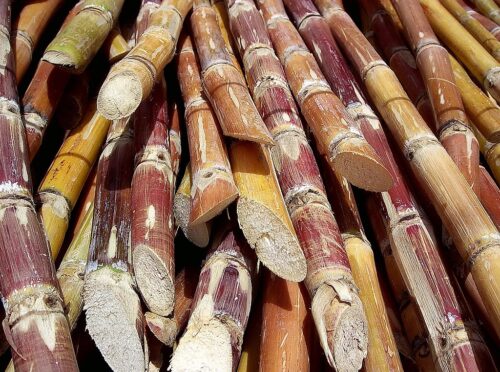
The first step in making rum is to extract the juice from the sugarcane or to obtain the molasses, which is a thick, dark syrup that remains after sugar crystals are separated from the juice. The juice or molasses is then diluted with water and yeast is added to start the fermentation process. The yeast converts the sugars into alcohol and carbon dioxide, creating a liquid called wash or wine.
The next step is to distill the wash or wine to increase the alcohol content and remove impurities. Distillation can be done in pot stills or column stills, depending on the desired flavor and style of rum. Pot stills produce a heavier, more aromatic rum, while column stills produce a lighter, cleaner rum. The distillate is then collected in different fractions, called heads, hearts, and tails. The heads contain the most volatile and undesirable compounds, such as methanol and acetone. The hearts contain the most desirable and flavorful compounds, such as ethanol and esters. The tails contain the least volatile and least desirable compounds, such as fusel oils and acids.
The final step in making rum is to age the distillate in oak barrels or other containers. Aging allows the rum to interact with the wood and oxygen, developing color, flavor, and aroma. The length and conditions of aging vary depending on the type of rum. Some rums are aged for only a few months, while others are aged for several years or even decades. Some rums are also blended with other rums or additives, such as caramel, spices, or fruits, to create different varieties and styles.
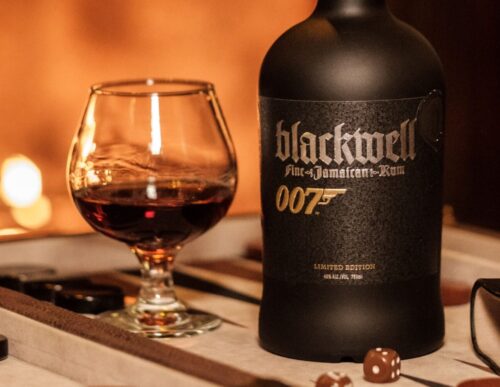
Grades of Rum
There are different grades of rum depending on the production process and the aging time. The most common grades are:
Light rum: Also called white or silver rum, this is a clear, mild and slightly sweet rum that is usually aged for a short time in stainless steel tanks or oak barrels. Light rum is often used for mixing cocktails, such as mojitos and daiquiris.
Gold rum: Also called amber or pale rum, this is a medium-bodied rum that has a golden color and a richer flavor than light rum. Gold rum is aged in charred oak barrels for a longer time than light rum, which gives it a smooth and slightly smoky taste. Gold rum can be used for mixing or sipping.
Dark rum: Also called black or navy rum, this is a full-bodied rum that has a dark color and a strong flavor. Dark rum is aged in heavily charred oak barrels for a long time, which gives it a complex and spicy taste with notes of caramel, molasses, vanilla and dried fruits. Dark rum is often used for baking, cooking or sipping.
Spiced rum: This is a rum that has been flavored with various spices, such as cinnamon, nutmeg, cloves, ginger, vanilla and pepper. Spiced rum can be made from any grade of rum, but it is usually based on gold or dark rum. Spiced rum can be used for mixing or sipping.
Overproof rum: This is a rum that has a higher alcohol content than the standard 40% ABV (alcohol by volume). Overproof rum can range from 50% to 80% ABV or more. Overproof rum is very potent and should be consumed with caution. Overproof rum can be used for mixing or flambéing.
Final Thoughts
Rum is a versatile and fascinating spirit that has a rich history and a diverse range of styles and flavors. Whether you enjoy it neat, on the rocks, or mixed in a cocktail, rum can offer you a satisfying and enjoyable drinking experience. Rum is also a cultural icon that reflects the heritage and identity of the Carribean and is now produced in nearly every sugar producing region of the world. The next time you sip a glass of rum, you can appreciate not only its taste, but also its story.
Resources
Blackwell Rum
BlackwellRum.com
Island Records
IslandRecords.com
The Official James Bond 007 Website
007.com
The Official Website for Ian Fleming
IanFleming.com
The National Museum of the Royal Navy
NMRM.org.uk
e views and opinions expressed on this website are solely those of the original authors and contributors. These views and opinions do not necessarily represent those of Spotter Up Magazine, the administrative staff, and/or any/all contributors to this site.
